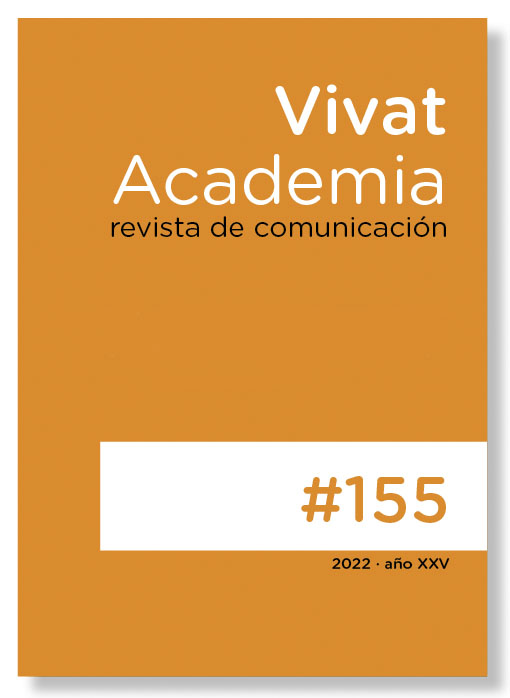Advertising use of Instagram by Spanish models before the AEA and autocontrol code of conduct
Main Article Content
Abstract
Influence marketing has become an essential tool for companies in general and especially for those that work in the fashion area. This article investigates, through the exploratory analysis of content, the presence on social networks and the content of the posts published in Instagram by the twenty most influential Spanish male and female fashion models according to Models.com. The advertising use and its engagement are studied. The results allow us to contrast the advertising strategy carried out by these influencers concerning the recent Spanish Association of advertising and Autocontrol code of conduct (2020).
Downloads
Article Details

This work is licensed under a Creative Commons Attribution-NonCommercial-ShareAlike 4.0 International License.
The main author must deliver the letter of transfer of copyright, according to the model provided by Vivat Academia, Revista de comunicación, which declares the transfer of copyright to the journal and make explicit the rights of authors regarding the dissemination and use of the manuscript once published.
Creative Commons Attribution/Non Commercial 4.0 International
References
Adán, L. (2016). El nuevo paradigma de la comunicación digital. Relación entre marcas y consumidores a través de Internet (TFG). Universidad de Sevilla. https://idus.us.es/xmlui/handle/11441/53191
Aguado Guadalupe, G. (2015). Inbound Marketing en LinkedIn para la gestión de marca, Icono 14, 13, 105-124. http://www.icono14.net/ojs/index.php/icono14/article/view/741
Antevenio Anticipation e-Marketing (9 mayo 2019). Las 10 campañas de influencer marketing más exitosas en 2019. https://bit.ly/2DGajUk
Anunciantes y Autocontrol (2020). Código de conducta sobre el uso de influencers en publicidad. https://bit.ly/3rVTjkU
Armano, D. (2011). Pilars of the New Influence. Harvard Business Review. https://bit.ly/2DEUFZg
Augure Launchmetrics (2017). Informe de Influencer Marketing 2017. https://bit.ly/2DBx8bC
Baena Graciá, V. (2011). Fundamentos de marketing: entorno, consumidor, estrategia e investigación comercial. UOC. https://bit.ly/2Rf0g0i
Cantoni, L. (2003). Fashion on-line. Come utilizzare il web per dare valore aggiunt alle aziende della moda. FrancoAngeli.
Castelló Martínez, A. y del Pino Romero, C., C. (2015b). Prescriptores, marcas y tuits: el marketing de influencia. aDResearch, 12, 86-107. https://doi.org/10.7263/adresic-012-05
Castelló-Martínez, A. (2016). El marketing de influencia: Un caso práctico. En I. Zacipa, V. Tur-Viñes y J. Segarra-Saavedra (Coords.), Tendencias publicitarias en Iberoamérica: Diálogo de saberes y experiencias (pp. 49-65). Alicante: Colección Mundo Digital. http://dx.doi.org/10.14198/MEDCOM/2016/8
Castelló-Martínez, A. y Pino-Romero, C. (2015a). La comunicación publicitaria con influencers. Redmarka: revista académica de marketing aplicado, 14, 21-50. https://doi.org/10.17979/redma.2015.01.014.4880
Castillo, A. (2006). Las relaciones públicas internas como factor de gestión empresarial. Anàlisi: Quaderns de Comunicació i Cultura, 34, 193-208.
Codina, M. y Herrero, M. (Eds.) (2004). Mirando la moda. Ediciones Internacionales Universitarias.
Consultor-SEO (2014). Usos de Instagram como herramienta de Marketing para empresas. https://www.consultor-seo.com/usos-de-instagram-como-herramienta-de-marketing/
Del Olmo, J.L. (2005). Marketing de la moda. Ediciones Internacionales Universitarias.
Digital Trends (2019). Conoce qué es WhatsApp, para qué sirve y por qué es tan popular. https://es.digitaltrends.com/celular/que-es-whatsapp/
García Orosa, B. (2005). Los altavoces de la actualidad. Radiografía de los gabinetes de comunicación. Netbiblo.
Gil Mártil, V.A. (2009). Coolhunting. El arte y la ciencia de descifrar tendencias. Urano.
IAB (2019). Estudio Anual de Redes Sociales. https://bit.ly/2XAaokQ
Martínez, E. y Vázquez, A.I. (2008). Marketing de la moda. Pirámide.
Mediakix (2019a). Influencer Marketing 2019 Industry Benchmarks. https://bit.ly/2q9Tm1c
Mediakix (2019b). The future of social media marketing: Trends shaping social media in 2019. https://mediakix.com/blog/future-of-social-media-marketing-trends/
Medium (2019). More about the brand of Nespresso. https://bit.ly/2OKZMh3
Models. MODELS.com’s Top Rankings. https://bit.ly/2SlloCa
Nocito Mora, M., de Moya Andrés, P., Gutiérrez Göttinguer, S., y López de Montenegro, B.R. (2017). La evolución del marketing tradicional al de influencia: los influencers. Colegio Orvalle. https://bit.ly/2HxrUlC
Padilla Castillo, G. y Oliver González, A.B. (2018). Instagramers e influencers. El escaparate de la moda que eligen los jóvenes menores españoles. aDResearch, 18, 42- 59. https://doi.org/10.7263/adresic-018-03
Pedrayes San Miguel, M. (2018). Los influencers como modelo publicitario en redes sociales. Universidad de Valladolid. https://bit.ly/2WvkXrU
Pérez Curiel, C. y Luque Ortiz, S. (2018). El marketing de influencia en moda. Estudio del nuevo modelo de consumo en Instagram de los millennials universitarios. adComunica. Revista Científica de Estrategias, Tendencias e Innovación en Comunicación, 15, 255-281. http://dx.doi.org/10.6035/2174-0992.2018.15.13
Rius (2006). Director de Área de Comunicación Global. Control, 527, 92-97.
Sánchez Herrera, J. y Pintado Blanco, T. (2010). Estrategias de marketing para grupos sociales. ESIC. https://catalogo.rebiun.org/rebiun/record/Rebiun02731267
Sanz-Marcos, P. y Pérez-Curiel, C. (2019). Branding e influencers en la comunicación de moda. Gucci como caso de estudio. Redmarka. Revista de Marketing Aplicado, 23(1), 21-39. https://doi.org/10.17979/redma.2019.23.1.5452
Saviolo, S. y Testa, S. (2007). La gestión de las empresas de moda. Gustavo Gili.
Segarra-Saavedra, J. y Hidalgo-Marí, T. (2018). Influencers, moda femenina e Instagram: el poder de la influencia en la era 2.0. Revista Mediterránea de Comunicación, 9(1), 313-325. https://www.doi.org/10.14198/MEDCOM2018.9.1.17
Segarra-Saavedra, J. y Hidalgo-Marí, T. (2020). Futbolistas en Instagram: análisis del marketing de influencia realizado por los capitanes de Primera División en España. Ámbitos, Revista Internacional de Comunicación, 48, 34-55. https://doi.org/10.12795/Ambitos.2020.i48.03
Torregrosa Puig, M., Noguera Tajadura, M., Sánchez Blanco, C. y Del Río Pérez, J. (2014). La moda en España ante la convergencia de Bolonia. Un estudio desde la perspectiva de la comunicación. Sphera Publica, 1, (14), 124-141. http://sphera.ucam.edu/index.php/sphera-01/article/view/174/190
Vanitatis (2 noviembre 2018). Qué significa el término prêt-à-porter y por qué supuso una revolución. https://bit.ly/2LvMoLF
Villena Alarcón, E. (2013). La gestión de la comunicación en las empresas de moda españolas. Servicio de Publicaciones de la Universidad de Málaga. http://hdl.handle.net/10630/5804
We Are Social (2020a). Global Digital Report 2020. https://bit.ly/38Ycm2Z
We Are Social (2020b). Digital 2020 España. https://bit.ly/39X6yZ1
Zaremba, J (2014). Marketing de influencia: que tu marca incendie las Redes Sociales. http://bit.ly/1lLgi9q





